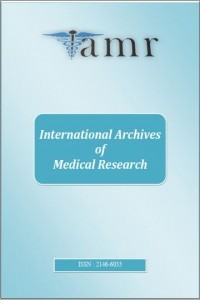Retrospective Analysis of 53 Cases who Developed Colon Fistula
Özet: Objektif: Kolon kanseri kadın ve erkeklerde sık görülen kanserler arasındadır. Rezeksiyon sonrası anastomoz ayrılması istenmeyen bir durumdur. Anastomoz kaçağı gelişmesine etkili çeşitli risk faktörleri vardır. Metod: Elliüç kolon anastomoz kaçağı olgusu retrospektif olarak çalışmada yer almıştır. Bu hastalarda demografik özellikler ve yandaş hastalıklar retrospektif olarak değerlendirilmiş ve risk faktörleri literatür ile karşılaştırılmıştır. Sonuçlar: Elliüç olgudan otuz vakada ek hastalık tespit edilmiştir. En çok tespit edilen yandaş hastalık diabetes mellitus(DM) ve hipertansiyon(HT) olup daha az sıklıkta ise kronik obstruktif akciğer hastalığı( KOAH) vb kronik hastalıklar tespit edilmiştir. Fistül gelişen hastalarda mortalite oranı %11 olup mortal olgularda genellikle DM ve HT birliktelik göstermektedir. Tartışma: KOAH'lı hastalarda yetersiz alveoler ventilasyon ve bunun sonucunda hipoksi ve hiperkapni, doku onarım süreçlerinde olumsuz etkiye sahiptir. Mikro sirkülasyondaki değişiklikler ve hastanın diyabetes mellitus (DM) ile ilişkili enfeksiyona daha fazla duyarlılığı postoperatif fistül gelişiminde risk faktörüdür. DM ile birlikte obezite de mevcut ise anastomoz kaçak riski daha da yüksek olabiliyor. Preoperativ diastolik yüksek basınç , anastomoz kaçak riskini arttıran diğer bir faktördür. Sonuç olarak hipertansiyon, obezite, diabet, KOAH , kolorektal cerrahi sonrası anastomoz kaçaklarında etkili risk faktörleridir. Bu risk faktörleri morbidite ve mortalite artışında etkili olmaktadır.
Retrospective Analysis of 53 Cases who Developed Colon Fistula
Objective: Colon cancer is among the most common cancers in men and women. Separation of anastomosis after resection is undesirable. There are various risk factors affecting the development of anastomotic leakage. Methods: Fifty-three cases of colon anastomotic leakage were included in the study retrospectively. Demographic characteristics and co-morbidities in these patients were evaluated retrospectively and risk factors were compared with the literature. Results: Additional disease was detected in thirty of fifty-three cases. The most common co-morbidities are diabetes mellitus (DM) and hypertension (HT), while less frequent chronic diseases such as chronic obstructive pulmonary disease (COPD) have been detected. Mortality rate is 11% in patients who develop fistula, and DM and HT usually coexist in mortal cases. Conclusion: Inadequate alveolar ventilation and consequently hypoxia and hypercapnia have negative effects on tissue repair processes in patients with COPD. Changes in the microcirculation and the patient's greater susceptibility to diabetes mellitus (DM)-related infection are risk factors for the development of postoperative fistula. If obesity is present together with DM, the risk of anastomotic leakage may be even higher. Preoperative diastolic pressure is another factor that increases the risk of anastomotic leakage. In conclusion, hypertension, obesity, diabetes, COPD are effective risk factors for anastomotic leakage after colorectal surgery. These risk factors are effective in increased morbidity and mortality. Keywords: colon, cancer, anastomosis, leakage, fistula
Keywords:
colon, cancer anastomosis, leakage, fistula,
___
- Ahmed M.Colon cancer: a clinician’s perspective in 2019. Gastroenterology research, 2020, 13.1: 1.
- Martinez, J. L., Luque-de-Leon, E., Mier, J. et al. Systematic management of postoperative enterocutaneous fistulas: factors related to outcomes. World journal of surgery, 2008, 32.3: 436-443.
- de Vries, F. E., Atema, J. J., van Ruler, O., et al. A systematic review and meta-analysis of timing and outcome of intestinal failure surgery in patients with enteric fistula. World journal of surgery, 2018, 42.3: 695-706.
- Topdagi O, Timuroglu A. Eighteen Years' Retrospective Review of Colorectal Cancer Cases in Eastern Population. Eurasian J Med. 2018 ;50(1):19-22.
- Anthonysaamy; M. A; Gotra, I. M; Saputra , H. Prevalence of colorectal carcinoma based on microscopic type, sex, age and anatomical location in Sanglah General Hospital. Intisari Sains Medis, 2020; 11: 272-276.
- Nguyen, L. H., Ma, W., Wang, D. D. , et al. Association between sulfur-metabolizing bacterial communities in stool and risk of distal colorectal cancer in men. Gastroenterology 2020;158.5: 1313-1325.
- Idigoras Rubio, I., Arana-Arri, E., Portillo Villares, I et al. Participation in a population-based screening for colorectal cancer using the faecal immunochemical test decreases mortality in 5 years. European journal of gastroenterology & hepatology 2019;31.2 : 197-204. Zhang, Z., Wang, A., Tang, X , et al. Comparative mutational analysis of distal colon cancer with rectal cancer. Oncology letters 2020;19.3 : 1781-1788.
- Ryan, É. J., Creavin, B., Sheahan, K. . Delivery of personalized care for locally advanced rectal cancer: incorporating pathological, molecular genetic, and immunological biomarkers into the multimodal paradigm. Frontiers in Oncology 2020;10: 1369.
- Buchs, N. C., Gervaz, P., Secic, M. et al. Incidence, consequences, and risk factors for anastomotic dehiscence after colorectal surgery: a prospective monocentric study. Int J Colorectal Dis 2008; 23.3: 265-270
- Ruggiero, R., Sparavigna, L., Docimo, G , et al. Post-operative peritonitis due to anastomotic dehiscence after colonic resection. Multicentric experience, retrospective analysis of risk factors and review of the literature. Ital Chir, 2011; 82: 369-375.
- Testini M, Miniello S, Piccinni G, at al. Correlazioni tra broncopatia cronica ostruttiva e deiscenza dell'anastomosi colica in età geriatrica (Correlation between chronic obstructive bronchial disease and colonic anastomosis dehiscence in the elderly). Ann Ital Chir. 2003;74(3):247-50.
- Sakr, A., Emile, S. H., Abdallah, E et al. Predictive factors for small intestinal and colonic anastomotic leak: a multivariate analysis. Indian Journal of Surgery, 2017;79.6: 555-562.
- Lin X, Li J, Chen W, at al. Diabetes and risk of anastomotic leakage after gastrointestinal surgery. J Surg Res. 2015;196(2):294-301.
- Post IL, Verheijen PM, Pronk A, at al. Intraoperative blood pressure changes as a risk factor for anastomotic leakage in colorectal surgery. Int J Colorectal Dis. 2012;27(6):765-772.
- Telem DA, Chin EH, Nguyen SQ, at al. Risk Factors for Anastomotic Leak Following Colorectal Surgery: A Case-Control Study. Arch Surg. 2010;145(4):371-376.
- ISSN: 2146-6033
- Yayın Aralığı: Yılda 2 Sayı
- Başlangıç: 2011
- Yayıncı: Veysi AKPOLAT
